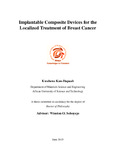| dc.description.abstract | Current standard of care treatment modalities for early-stage breast cancer typically involve mastectomy or lumpectomy followed by radiation therapy to remove any residual cancer cells. Although mastectomy has a low recurrence rate, it is an aggressive form of treat-ment for early-stage breast cancer. Therefore, there is a need for the development of new strategies that could increase the use of lumpectomy by eliminating residual cancer cells
to reduce local recurrence with limited side effects. Our research group has previously reported in-vitro hyperthermia via Joule heating by patterned metallic thin films embedded in poly-dimethylsiloxane (PDMS) as a potential treatment method that can kill residual cancer cells. In order to move to in-vivo applications, we developed a model for the estimation of the damage zones created by the device in biological media and also explored new heating mechanisms.
First, we developed a three-dimensional coupled finite element method (FEM) model that enables the prediction of thermal damage. The model was validated with experimental results. Secondly, we explored the use of magnetic nanoparticle (MNP) heating as an alternative to Joule heating that was used in the previous studies. MNP-reinforced PDMS composites (nanocomposites) were fabricated and characterized to determine their structural, magnetic and thermal properties. In an effort to explore in-vivo thermal pro-files due to heating by the nanocomposites, we modified the FEM model developed earlier. Heat generation was calculated using the linear response theory.
Thirdly, we proposed a novel nanocomposite-based probe and analysed it using in-silico methods.
Lastly, using a combination of experiments and models, we investigated the mechanical and hyperthermic properties of nanocomposites for the development of selected biomedical devices. Predictions by the FEM models agreed well with experimental data. Nanocomposite properties
were shown to be dependent on the properties of MNP, and characteristics of lesions were shown to be dependent on device geometry and treatment parameters (time and temperature).
The results suggest that these multifunctional composites have the potential to kill residual breast cancer cells after lumpectomy. | en_US |

